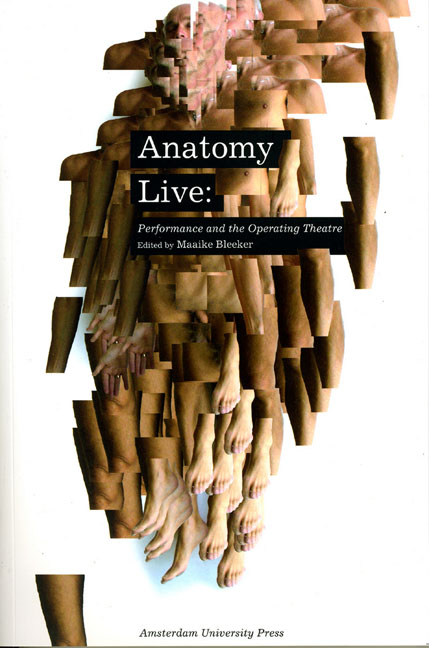Book contents
- Frontmatter
- Contents
- Acknowledgements
- Prologue - Men with Glass Bodies
- Introduction
- Performance Documentation 1: Holoman; Digital Cadaver
- Digital Cadavers and Virtual Dissection
- ‘Who Were You?’: The Visible and the Visceral
- Performance Documentation 2: Excavations: Fresh but Rotten
- The Anatomy Lesson of Professor Moxham
- ‘Be not Faithless But Believing’: Illusion and Doubt in the Anatomy Theatre
- Performance Documentation 3: De Anatomische Les
- Of Dissection and Technologies of Culture in Actor Training Programs – an Example from 1960s West Germany
- Ocular Anatomy, Chiasm, and Theatre Architecture as a Material Phenomenology in Early Modern Europe
- Performance Documentation 4: Camillo – Memo 4.0: The Cabinet of Memories – A Tear Donnor Session
- Martin, Massumi, and the Matrix
- Performance Documentation 5: Sensing Presence no 1: Performing a Hyperlink System
- ‘Where Are You Now?’: Locating the Body in Contemporary Performance
- Performance Documentation 6: Under My Skin
- Anatomies of Live Art
- Performance Documentation 7: Crash
- Restaging the Monstrous
- Delirium of the Flesh: ‘All the Dead Voices’ in the Space of the Now
- Performance Documentation 8: Körper
- Operating Theatres: Body-bits and a Post-apartheid Aesthetics
- Index
Martin, Massumi, and the Matrix
Published online by Cambridge University Press: 10 February 2021
- Frontmatter
- Contents
- Acknowledgements
- Prologue - Men with Glass Bodies
- Introduction
- Performance Documentation 1: Holoman; Digital Cadaver
- Digital Cadavers and Virtual Dissection
- ‘Who Were You?’: The Visible and the Visceral
- Performance Documentation 2: Excavations: Fresh but Rotten
- The Anatomy Lesson of Professor Moxham
- ‘Be not Faithless But Believing’: Illusion and Doubt in the Anatomy Theatre
- Performance Documentation 3: De Anatomische Les
- Of Dissection and Technologies of Culture in Actor Training Programs – an Example from 1960s West Germany
- Ocular Anatomy, Chiasm, and Theatre Architecture as a Material Phenomenology in Early Modern Europe
- Performance Documentation 4: Camillo – Memo 4.0: The Cabinet of Memories – A Tear Donnor Session
- Martin, Massumi, and the Matrix
- Performance Documentation 5: Sensing Presence no 1: Performing a Hyperlink System
- ‘Where Are You Now?’: Locating the Body in Contemporary Performance
- Performance Documentation 6: Under My Skin
- Anatomies of Live Art
- Performance Documentation 7: Crash
- Restaging the Monstrous
- Delirium of the Flesh: ‘All the Dead Voices’ in the Space of the Now
- Performance Documentation 8: Körper
- Operating Theatres: Body-bits and a Post-apartheid Aesthetics
- Index
Summary
‘This is anatomy that is alive,’ claims Gunther von Hagens in a promotional video about his famous exhibition Body Worlds. Body Worlds presents dead bodies preserved via a technique called ‘plastination ‘ and presented in postures and configurations meant to show viewers how it is with us, in our living bodies. The exhibition thus reiterates what might be called one of the central paradoxes of anatomy, namely the use of dead bodies to teach about living ones. Von Hagens invites us to identify our living selves with these dead ones; these bodies are real, he claims. But what exactly is so real about them? The bodies on display are real dead human body material, complete with glass eyes, dyed to look like living tissue. They are bodies reduced to the Cartesian res extensa, preserved and fixed in positions that these bodies may or may not have assumed when alive. Does posing as if they are alive make them live? (Does posing as if he is Joseph Beuys make Gunther von Hagens an artist?)
What would make anatomy alive, rather than a re-staging of the dead, would be to rethink the body itself, this is res extensa, as the ‘very stuff of subjectivity’ (Grosz, 1994). To do this is to undo the deadly fixations of the Cartesian paradigm and rethink the body as that which does the thinking, knowing and understanding. The question then is not, or not only, what we imagine living bodies to look like, but also how living bodies are involved in looking, and in imagining. What are the implications of this involvement for our understanding of what it means to look, what it means to imagine, what it means to think?
A crucial question here is that of movement. In this respect, Von Hagens's project presents an interesting example. In his staging of ‘anatomy that is alive’, a lot of effort is invested in suggesting movement, bodily action, and activity. We see dead bodies ‘playing’ chess, ‘throwing’ a lasso. They are ‘fencing’, or about to walk away. They seem to be frozen in mid-movement, in poses that bring to mind artistic strategies of suggesting movement used in painting or sculpture.
- Type
- Chapter
- Information
- Anatomy LivePerformance and the Operating Theatre, pp. 151 - 164Publisher: Amsterdam University PressPrint publication year: 2008



